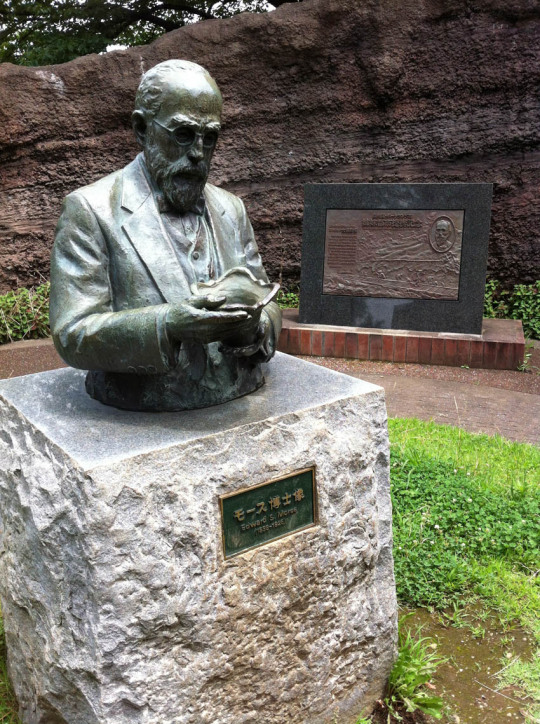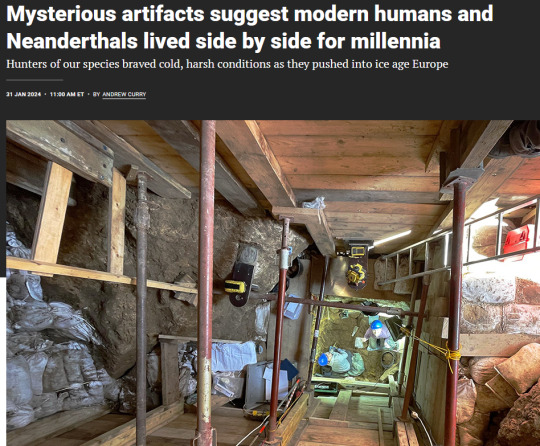#palaeolithic
Explore tagged Tumblr posts
Text





Prehistoric 'Swimming' Reindeer Mammoth Tusk Carving, 'Ice Age Art Now' Exhibition, Cliffe Castle, Keighley, Yorkshire
Posed with their chins up, antlers tipped back, and legs outstretched, the reindeer appear to be swimming as they do when crossing lakes and rivers on migration. This made the best use of the tapering tip of the mammoth tusk. The wavy lines on the male's face may represent water.
Montastruc rockshelter, Midi-Pyrenees, France British Museum, Palart.550
#palaeolithic#mesolithic#hunter gatherer#reindeer#swimming reindeer#mammoth tusk#mammoth#ancient cultures#ancient beliefs#ancient living#artwork#carving#archaeology#prehistoric#movement
454 notes
·
View notes
Text

'Young Reindeer With Its Mother' Bone Carving, 'Ice Age Art Now' Exhibition, Cliffe Castle, Keighley, Yorkshire
Around 15,000 years ago, as winter turned to spring, feelings of hope perhaps inspired this superb, engraved drawing of a reindeer calf alongside its mother on bone.
La Madeleine Rockshelter, Dordogne, France
#ice age#prehistoric#prehistory#bone carving#reindeer#palaeolithic#hunter gathers#bone#prehistoric art#artwork#design#carving#archaeology#exhibition#cliffe castle#cave#rockshelter
433 notes
·
View notes
Text

A Wooly Mammoth Valentine
#paleoart#paleontology#palaeontology#palaeoblr#palaeolithic#palaeoart#wooly mammoth#wooly mammoths#pleistocene#stone age#pleistocene megafauna#valentine’s day art#valentine’s day#valentine’s day card#valentine's card#valentines gifts#valentine#valentines#happy valentine's day#happy valentines#valentines week#valentines aesthetic#mammoths#mammoth#cenozoic
421 notes
·
View notes
Text


Reconstruction of the La Poire Venus (original from the paleolithic era)
30 notes
·
View notes
Text

Western Stemmed Tradition: this is a prehistoric native American culture which first appears in North America, roughly between 11,200-9000 BC, and possibly earlier when considering more recent finds.
#history#historyfiles#ancient world#archaeology#western stemmed#prehistoric#america#early america#palaeolithic#north america
8 notes
·
View notes
Text
I was thinking about cave art this morning and found myself wondering why they only painted in caves. But of course they didn't, it's just that the caves preserved their art. I bet they painted every available surface. I bet the stone age world was trailed with art everywhere humans went.
We cannot resist leaving beauty behind us.
#stone age#palaeolithic#palaeolithic art#cave art#beauty may be a stretch#it was probably crudely remdered cocks most of the time#humans don't change that much
4 notes
·
View notes
Text
i am interested in whether people truly believe neanderthals and modern humans completely lived in caves? or, if people realise that the perception of them soley dweliing in caves is due to preservation bias of open air sites, and (now) submerged landscapes. caves weren't a stable 'home', but instead an opportuntistic and utilised at certain periods of the year.
#yes there are caves that had evidence for continual use or occupation but it would have been on a rotating basis.#palaeolithic#sorry these are my thoughts on the increasing amount of posts im seeing about this & 'cavemen'.#fandom psoiting will continue shortly.
4 notes
·
View notes
Text





Sean bienvenidos japonistasarqueológicos, a una nueva entrega de arqueología japonesa, una vez dicho esto pónganse cómodos que empezamos. - En esta ocasión os voy a presentar al padre de la arqueología moderna japonesa Edward.S.Morse, zoólogo estadounidense del siglo XIX y gran apasionado por el mundo japonés, su hallazgo más relevante fue el montículo de conchas de Omori, cuando lo divisó desde el tren ha raíz de dicho hallazgo, fue venado descubrió la cultura prehistoria Jomon. - En la foto se puede apreciar el Montículo de conchas Omori en el momento de la excavación de Morse, en el año 1878 aproximadamente. ¿Lo conocían? - Espero que os haya gustado y nos vemos en próximas publicaciones, que pasen una buena semana. - 日本の考古学者たちよ、ようこそ。そう言われたら、くつろいで、さっそく始めましょう。 - 今回は、近代日本考古学の父、エドワード・S・モース(19世紀アメリカの動物学者で、日本の世界をこよなく愛した人物)を紹介します。彼の最も重要な発見は、大森貝塚で、汽車から貝塚を発見したとき、先史時代の縄文文化を発見したのです。 - 写真は、1878年頃、モースが発掘した当時の大森貝塚です。 ご存知でしたか? - 気に入っていただけたでしょうか、また今後の記事でお会いしましょう、良い一週間をお過ごしく���さい。 - Welcome, Japanese archaeologists, to a new installment of Japanese archaeology, and once that's been said, make yourselves comfortable and let's get started. - On this occasion I am going to introduce you to the father of modern Japanese archaeology Edward.S.Morse, 19th century American zoologist and great enthusiast for the Japanese world, his most relevant find was the Omori shell mound, when he spotted it from the train, he discovered the prehistoric Jomon culture. - The photo shows the Omori shell mound at the time of Morse's excavation in about 1878. Did you know it? - I hope you liked it and see you in future posts, have a nice week.
#日本#先史時代#旧石器時代#上毛時代#考古学#ユネスコ#遺跡#横浜#新橋#エドワードシルベスターモース#大森貝塚#日本史#-#japan#prehistory#palaeolithic#Jomoperiod#archaeology#unesco#archaeologicalsite#Yokohama#Shimbashi#EdwardSylvesterMorse#Omorishellmound#Japanesehistory
12 notes
·
View notes
Text
Why didn't someone tell me that researching a niche area of archaeology would be difficult... its almost as if there's barely any research on this... who could have known... :'D
#archeology#archaeology#prehistory#prehistoric#research#EPQ#arabian peninsula#palaeolithic#neolithic#ancient history#classics#dark academia#dark acadamia aesthetic#burial practices#mortuary archaeology#burial rites#research project
8 notes
·
View notes
Note
Favorite historical time period(s)?
I've got a few favourites.
My current is the early Upper Palaeolithic in Europe. I've mentioned the time abyss factor in my most recent post, but there's more.
I've been a fantasy fan for a long time. As you may know, there's a fantasy trope, used by both Tolkien and (Robert E.) Howard, where the fantasy setting is ostensibly the earth in the prehistoric past. Then I get The Handbook of British Archaeology as a 16th birthday present and I discover that trope happened in real life.
Europe had a climate and ecology like that of Mongolia, the landscape was dominated by reindeer, mammoths and wild horses, there were "monsters" (mammoths, cave lions, scimitar cats, etc.), "fantasy races" (Neanderthals and humans coexisted and interbred for several thousand years) and "wandering monster fighters" (everyone).
The Middle Palaeolithic was my first love after discovering that Neanderthals were far more developed than pop culture would tell you they are (they had javelins, string, glue, jewellery, music, etc.), but I'm falling in love with the Upper Palaeolithic for having cool stuff like cave paintings, the Vogelherd Cave figurines (if you haven't heard of them, look them up) and the first definitive evidence of religion. I'm picking the early Upper Palaeolithic because it's where the two meet.
As for Europe, well, it's the one I know most about, and since I live there (Britain, specifically), as do all the ancestors I know of, I feel naturally close to it.
11 notes
·
View notes
Text
DENNY: A NEEDLE IN THE HAYSTACK OF HUMAN EVOLUTION.
DENNY: UNA AGUJA EN EL PAJAR DE LA EVOLUCIÓN HUMANA.
DENNY: UN AGO NEL PAGLIAIO DELL'EVOLUZIONE UMANA.

(English / Español / Italiano)
The Max Planck Institute for Evolutionary Anthropology did it again by publishing in Nature a couple of years ago the discovery of the first direct offspring of two different human species.
"Denny" (Denisova 11 for Science) was a teenage girl who lived 50,000 years ago in the Denisova cave (Altai) and left us at the age of 13.
His mother was a Neanderthal female and his father was a Denisovan. That makes Denny the first first-generation hybrid human found so far.
We know that Denisovans and Sapiens hybridised somewhere and sometime (very little is known about the mysterious Denisovans compared to other human species) because they left part of their genetic legacy in today's original human communities in Australia and Oceania.
We also know that Neanderthals and Sapiens hybridised and the proof is in our genetic map.
But in Denny's case, it is the first time that a direct (first generation) descendant of two different human species has been found.
What secrets did he keep?
We will be telling you about them as we get to know them. But for the time being, as expected, Denny was not alone 😉
-----------------------------------------------------------------------------
El Instituto Max Planck de Antropología Evolutiva volvió a hacerlo publicando en Nature hace un par de años el descubrimiento de la primera hija directa de dos especies humanas distintas.
"Denny" (Denisova 11 para la Ciencia) era una adolescente que vivió hace 50.000 años en la cueva de Denisova (Altai) y nos dejó a la edad de 13 años.
Su mamá era una mujer neandertal y su papá era denisovano. Eso convierte a Denny en el primer humano híbrido de primera generación encontrado hasta el momento.
Sabemos que denisovanos y sapiens hibridaron en algún momento y en algún lugar (es muy poco lo que se conoce sobre los misteriosos denisovanos comparándolo con otras especies humanas) porque dejaron parte de su legado genético en las comunidades originarias humanas actuales de Australia y Oceanía.
Sabemos también que neandertales y sapiens hibridaron y la prueba está en nuestro mapa genético.
Pero en el caso de Denny es la primera vez que se encuentra a una descendiente directa (de primera generación) de dos especies humanas diferentes.
¿Qué secretos tenía guardados?
Os los vamos a ir contando conforme los vayamos conociendo. Pero de momento os adelantamos que, como era de esperar, Denny no estaba sola 😉
-----------------------------------------------------------------------------
L'Istituto Max Planck per l'antropologia evolutiva lo ha fatto di nuovo, pubblicando su Nature un paio di anni fa la scoperta della prima discendenza diretta di due specie umane diverse.
"Denny" (Denisova 11 per la scienza) era un 'adolescente vissuta 50.000 anni fa nella grotta di Denisova (Altai) e ci ha lasciato all'età di 13 anni.
Sua madre era una femmina di Neanderthal e suo padre un Denisovano. Questo fa di Denny il primo ibrido umano di prima generazione finora trovato.
Sappiamo che i Denisovani e i Sapiens si sono ibridati da qualche parte e in qualche momento (si sa molto poco dei misteriosi Denisovani rispetto alle altre specie umane) perché hanno lasciato parte della loro eredità genetica nelle attuali comunità umane originarie in Australia e Oceania.
Sappiamo anche che Neanderthal e Sapiens si sono ibridati e la prova è nella nostra mappa genetica.
Ma nel caso di Denny, è la prima volta che viene trovato un discendente diretto (di prima generazione) di due specie umane diverse.
Quali segreti ha mantenuto?
Vi parleremo di loro man mano che li conosceremo. Ma per il momento, come previsto, Denny non era sola 😉
Source: ArqueoEduca
#palaeolithic#paleolitico#denisova#neanderthal#homo sapiens#denisovani#denisovans#evolutionary anthropology#antropologia evolutiva#Max Planck Institute
3 notes
·
View notes
Text




Prehistoric Sculpted Clay Bison from Tuc d'Audoubert Cave, 'Ice Age Art Now' Exhibition, Cliffe Castle, Keighley, Yorkshire
Deep underground sculptures of a male and female bison are spectacularly staged in the middle of a small chamber. Made from unfired clay dug from the cave floor, these statues are shaped by hand and detailed using bone spatulas. They represent a bison bull behind a cow. Accurately proportioned, this natural scene shows the male sniffing the air for the females' scent. Her tail, now broken off, is raised ready to mate which happens in September. Finger marks suggest the involvement of five or six makers on a single occasion and the installation is surrounded by heel and footprints of adults and children celebrating the significance of the scene.
Replica made by Philippe Lacomme of Toulouse Museum in 1933, British Museum.
#bison#clay#cave#archaeology#symbols#animal#beast#palaeolithic#ancient history#ancient living#ancient crafts#ancient art
153 notes
·
View notes
Text

"H. sapiens originated in the tropical latitudes of Africa. Given the lack of evidence for tailored clothing prior to about 40,000 years ago, researchers long assumed early modern humans took advantage of periodic warm spells to venture north into Europe.
Yet the finds at Ranis confirm that the cold was no barrier. Within a few millennia or less, small bands of modern humans evidently transitioned from tropical or subtropical forests and grasslands in southwest Asia and the Mediterranean to northern Europe’s treeless, icy steppe."
#science#research#europe#early humans#archaeology#anthropology#palaeolithic#prehistory#early modern human#neanderthals#very exciting
3 notes
·
View notes
Text
youtube
Paleoanthropologist Ludovic Slimak breaks down Neanderthals in movies
5 notes
·
View notes
Text

Palaeolithic Oceania: this period in Oceania marks the arrival of modern humans in the region, although it can also be extended to cover the existence of older human types.
2 notes
·
View notes